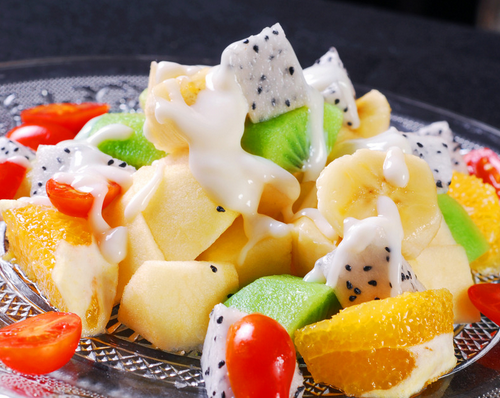Fruit salad is a healthy and delicious dessert or snack, and it is also a part of a healthy diet. Here is a more detailed exploration of the nutritional value, ingredients, preparation methods, consumption methods, and other considerations of fruit salad.
Nutritional Value
Fruit salad is made up of various fresh fruits, which are rich in nutrients such as vitamins, minerals, and dietary fiber. The vitamins, including vitamin C, vitamin A, and B vitamins, play essential roles in immune system support, wound healing, and vision health. The minerals, including potassium, magnesium, and calcium, contribute to normal heart, bone, and nervous system function. The dietary fiber supports digestive health and helps regulate blood sugar and cholesterol levels.
In addition, the natural sugar found in fruits provides energy, and the fructose in fruits is healthier than processed sugar. The antioxidants in fruits, such as flavonoids and anthocyanins, have anti-inflammatory and antioxidant properties that may protect against chronic diseases.
Ingredients
Choosing fresh and diverse fruits is key to making a great fruit salad. In season fruits are the freshest and have the highest nutritional value, so they should be prioritized. Some common ingredients for fruit salad include strawberries, blueberries, oranges, apples, pears, pineapples, and mangos. You can also experiment with less common fruits such as pomegranates, persimmons, figs, and more. In addition to fruits, vegetables like cucumbers, tomatoes, and lettuce can be added to provide extra texture and flavor.
To control calories, low-fator dressing can be used as a topping. Nuts like almonds, walnuts, or pecans can also be sprinkled on top to add more crunch. For an extra touch of flavor, herbs like mint or lemon balm can be added.
Preparation
Preparing a fruit salad is relatively simple but attention to freshness and balance is important. Start by thoroughly washing all the fruits and vegetables. Remove the peels and seeds as needed. Cut the fruits into bite-sized pieces or slices. Toss the prepared fruits and vegetables in a bowl or on a platter. Drizzle with your choice of low-fator dressing and gently mix to coat all the ingredients. For more texture, add nuts or herbs as mentioned earlier.
To preserve nutrients and flavor, it is best to refrigerate the fruit salad before serving. Portion control is also important to avoid overeating and excessive sugar intake. When preparing the fruit salad, ensure that all cutting boards and utensils are clean to prevent food safety risks like food poisoning.
Consumption
Fruit salad can be served as a dessert after a meal or as a snack between meals. It can also be used as a light meal replacement if desired. Eat the fruit salad directly out of the bowl or use a fork and knife to eat it from a plate. For a more indulgent experience, wait for a short while for the flavors to develop before eating. To control calories if needed, reduce the amount of dressing used or choose a lower-calorie option.
Additional Considerations
- For people with diabetes or high blood sugar levels, it is important to manage their intake of fruit salad as some fruits contain higher amounts of natural sugar. They can choose lower-sugar fruits or reduce the amount of sugar they add to their salad if needed.
- People with allergies should avoid fruits and vegetables that cause allergic reactions for them. It is important to read labels or consult a doctor when choosing ingredients for a fruit salad if there are known allergies in the household.
- Storage: To ensure freshness and food safety, it is important to store fruits properly. Keep fruits in a dry and well-ventilated place to prevent moisture buildup and mold growth. Avoid storing fruits that are already ripe with those that are not yet ripe to prevent cross-contamination.
- Food safety: It is essential to practice good hygiene when preparing fruit salads to avoid food poisoning and other food safety risks. Always wash hands thoroughly before handling raw fruits and vegetables. Use clean cutting boards and knives when cutting fruits and vegetables. Store ingredients in clean containers or sealable bags to prevent cross-contamination between ingredients. Check ingredients for any signs of spoilage before using them to ensure food safety.

